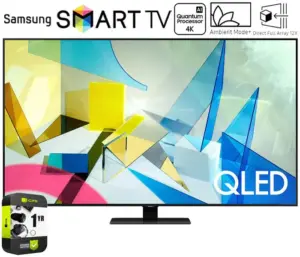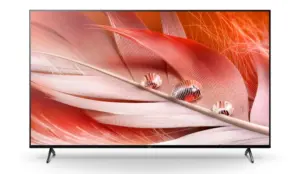Are you looking for the best TV to buy? We’re covering for you. Although it’s the start of the year, we looked at the largest, brightest, and most functional TV in 12 months and compiled the essential guide for potential buyers.
Some of our choices are the absolute chrome of the products available today, but we have highlighted a lot of TVs that cost you money. It also offers incredible value. Collectively, you have a list of the best TVs of any budget.
That being said, we always add more screens to this list, so make sure you come back in a month or two to see the latest additions to this Hall of Fame TV.
What is 8K?
An 8K Television is a TV with having screen with 7,680 horizontal and 4,320 vertical pixels for a total of around 33 million pixels. In 8K The “K” stands for Kilo (1000), which means a TV that has achieved a resolution of about 8,000 pixels horizontally.
8K TV is the highest resolution TV which was released recently among UHD (ultra-high definition) TVs. With four times more pixels than a 4K TV—another type of UHD resolution—8K TVs show more detailed picture quality and sharpness. This is because in 8K TVs pixels are extremely small they cannot be distinguished even from close-ups, this makes highly detailed images show as real images.
Difference In Image Quality 4K vs 8K
So, how good are 8K TVs compared to traditional TVs? Let’s compare them to Full HD TVs and 4K UHD TVs to find out.
The resolution of 8K TVs is 4 times higher than 4K UHD TVs and 16 times higher than full HD TVs. High resolution means more pixels make up the screen. On TVs of the same size, the pixels are filled with more space in the same area allowing the image to be a more sophisticated and realistic representation. It gives you a great sense of immersion while watching TV.
The term used to describe the number of pixels in a term is called PPI (pixels per inch) and naturally, a high PPI number means high pixel density. Generally, the PPI must be at least 50 or higher to enjoy a wide variety of video content. Having said that, on an 8K 75 “TV, the PPI is 117, while on a 4K TV and FHD TV, it’s 59 PPI and 29 PPI, respectively.
Samsung Q80T QLED TV
The Samsung Q80TQ LED looks at the achievements of previous models for an amazing HDRTV that is worth checking out.

The most notable feature is the incredibly low input range, which makes the Q80T a great choice for gamers who want a responsive game, but QLED screens are also a pleasure to watch.
The Q80T is Samsung’s cheapest new TV that comes with a full range of backlights, which means you’ll get permanent brightness, even if the high-end set doesn’t have some premium features – so that’s why this list is smaller than last year’s Q90. QLED. Not as sleek as the Zero Bezel Q950TS, it has a thicker body than other QLEDs in this year’s range.
However, you will get the latest Quantum 4K processor from Samsung, vivid HDR colours and advanced smart TV functions through the Tizen operating system.
If you want even more savings, the Q70R QLED is the forerunner of this TV and will cost you a few hundred dollars less than the Q80T (yes, this is a product line and yes, its name is confusing).
Sony A8H OLED
Combining the premium performance of Sony’s OLED image with a powerful live sound system, the Sony A8H OLED TV manages to be an excellent television option for home cinema fans.
It features Sony’s X1 Ultimate processor, Sony’s Pixel Contrast Booster (for more iconic highlights) and the X Motion Clarification feature.
As for the audio, meanwhile, Sony’s traditional audio system at the sound level (where the TV screen is really “excited” to produce sound) includes a bass system with two subwoofers and an Austrian V-auto calibration system. improve the sound in the room with just a few test pulses.
Sony Bravia X900H Series
Sony’s X900H series does everything you want in a special way. The quality of the image in the right conditions is quite amazing, its sound is much higher than the current standards, it is easy to use and does not raise its nose to low-resolution material.

The panel itself is a VA-type LCD screen, which, in general, should be considered an upgrade to Sony’s edge-bright IPS panel, which was implemented on a similar model last year. The Full Matrix VA panel should pay more attention to narrower angles than viewing for higher brightness, higher colour volume and better screen uniformity than IPS. It is also worth noting that the X900H does not feature X-Wide viewing technology. The top limit of the Sony X950H is everything.
Most Wanted
In short, more than enough things are happening here to make you ignore the lack of HDR10 + and forgive Android TV for its greater trust. If you have the money to spend on a TV of this size, you need to listen to it.
LG CX Series OLED TV
The LG CX OLED is the OLED TV we’ve seen in the last year and deserves to be removed at the top of the list of the best TVs available today. Speaking of last year’s LG C9 series, the LG CX doesn’t look any different. And it’s not. But with some of the latest updates, such as HDMI 2.1 and A9 Gen 3 processors, continuing the same glamorous image quality and the remarkable platform of the remarkable web operating system, it has managed to surpass its predecessor.
A 48-inch OLED TV is still available, but the CX is a more flexible proposition for a variety of wallets and even homes. Belby with built-in audio – with a slim design and support for Dolby Vision and Atmos – is a great choice in any size.
LG wants to turn on players as well, with basic input intervals, Nvidia G-Sync support and 4K / 120HZ game synchronization for the latest generation consoles.
Unfortunately, you won’t find HDR10 + here, and viewers in the UK will have to go without all their limitations, but make no mistake – this is the best OLED TV for you right now.
Samsung Q950TS QLED TV
Reasons to buy
- Amazing image quality
- HDR with standard configuration
Reasons to avoid
- It does not support Dolby Vision
- Limited 8K content
- The Samsung Q950TS is the latest flagship 8K TV from the manufacturer, which combines all the advantages of the Samsung Q9008 screen.
Combined with a high-quality LED TV, the new Samsung Q950 features an enhanced 8K panel and AI imaging processing, wider viewing angles, an improved black filter and standard HDR performance. If that weren’t enough, the Samsung Smart TV platform is the most comprehensive on the market.
So if you’re looking for a new, state-of-the-art Samsung TV – and you don’t mind paying a dollar for it – the Q950TS should be at the top of your shortlist.
LG GX Gallery Series OLED
Reasons to buy
- Beautiful image quality
- Perfect high
- Unusual feature set
Reasons to avoid
- LED – not as bright as LCD TVs
- Balanced audio performance
- Slightly reflective glass surface
- For those who can afford it, the LG Gallery Series GX OLED is the dream of home theatre lovers. An ideal flat screen, using all the latest features and standards from Dolby Vision and Atoms to Google Assistant and Amazon Alexa, from Chromecast to AirPlay 2.0.
While the exterior is a marvel of engineering and industrial design, inside it you have the new LG Alpha a9 Generation 3 which adds face recognition and multi-step noise reduction to LG’s already great HD-4K upscaling and much better motion processing technology.
Most Wanted
But if you are looking for the perfect sound, you will not find it in the LG Gallery series. Due to design constraints, the TV has only lean, low-powered speakers that do not easily match the premium performance of OLED panels.
That being said, if you buy a TV for 3,000, you have a home sound system ready, and apart from a few other nitpicks, it’s a great TV.
TCL 6-Series QLED with MiniLED
We were surprised to learn that the new TCL 6 Series 2020 will use QLED (R635) MiniLED. This is because, just a year ago, the same technology succeeded in the latest 8 series and cost hundreds of dollars more than the extremely cheap 6 series.
This is not an LCD LED, in the end, which I dreamed would be due to its limited brightness and poor handling of movement, but it is an exceptional value and one that everyone recommends Will do
The 6 Series is brighter, more colourful, and has no signs of light halo or bleeding. It’s designed in a new way to hide your cables and is the first TV to come with THX-certified game mode in 1440p / 120Hz games.
This isn’t exactly the TV we recommend for next-generation gamers looking for a perfect Xbox Series X or PS5 partner that can push 4K at 120 fps, but if you have a TV to suppress Netflix When shopping, basically run the Hulu or, enjoy your viewing experience, this is the TV I recommend.
Hisense H8G Quantum Series
Reasons to avoid
- The design is a bit sad
- Android TV can run a bit slow
- The Hisense H8G Quantum Series is a great choice for those who want to spend less and receive more.
For just $ 700 for the 65-inch version of the Hisense H8G, it’s a valuable addition. You don’t have to settle for a sub-standard set, but because apps are easy to find and use, Google Assistant is well-implemented, and the technical specifications compete with the more expensive models. Despite the lack of brightness compared to competing QLED models, with excellent performance in HD and 4K videos, the movement is also excellent.
You won’t get the quality experience of many other people from this list, and the design of this set will not be much affected. For the price, however, the Hisense H8G Quantum Series offers.
Samsung Q70T QLED TV
The new Samsung Q70TQ LED TV boasts a plethora of features found in Samsung’s expensive 4K QLED screens, but it doesn’t come at such a reasonable price – which they can’t afford. So this is a great purchase. Pair a thousand Samsung Q95T 8K flagship.
The reason it doesn’t have a high score on our list is that it is a TV that has edge lighting and does not produce the same contrast with the entire matrix model that compares, especially in rooms with low light. In the cinema
Most Wanted
However, Samsung’s Q70T is a great 4K TV. Ideal for bright camera viewing, it offers excellent detail and colour performance, has a fully integrated platform and has an excellent image barrier.
For athletes, the Q70T is a great idea. Not only is the icon delayed, but without any processing, a 120 fps 4K HDMI is waiting for your next game console. It is also confusing when it comes to black-level performance and screen uniformity provided you keep the lights on.
Vizio P-Series Quantum X
Reasons to Avoid
- The smart cassette can be turned off
The Visual P Series Quantum X is an impressive LED-LCD TV that combines the brightness of QLED and some of the best black levels on this side of OLED. Offering a maximum brightness of over 2,000 nuts, it illuminates any home cinema and reduces ambient light to become one of the best TVs for low-light rooms – and the recent firm Thanks to the software update, it’s now a perfect fit for the Xbox X and PS5 series with 4K / 120hz support, 4K / 120hz support, low latency mode and 13ms response time.
That being said, it’s not without its flaws. Such bright TVs are a must-have, as you can see when you have white text on a black background, and its modernization – although much better than in previous years – Yes, Samsung is not on the level of Sony TVs. Similarly, due to the addition of Apple TV Plus, Disney Plus and Moore, the SmartCast is much better than in previous years, but sometimes it also slows down with disappointment.
If you have really deep pockets and you want the best image quality out there, it’s still worth looking for LG OLED or Samsung QLED TVs – but in the absence of a six-figure pay-per-view, the Vizio P-Series Quantum The X P99QX-H1 for 5,599 is a great option for those who want quantum dot technology in smart TVs at a visual price level.



